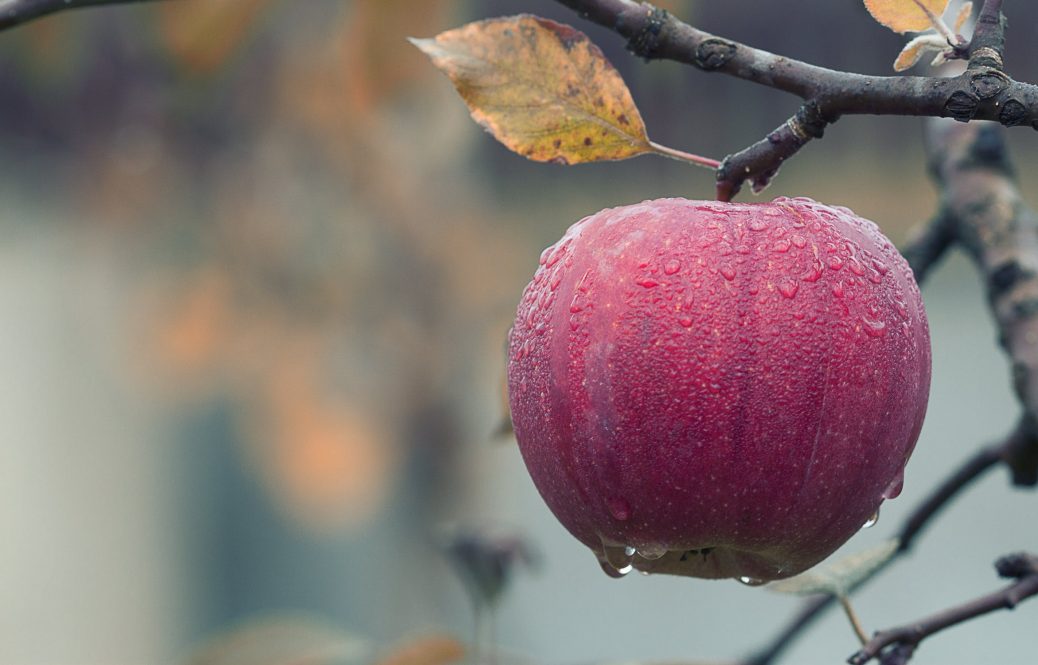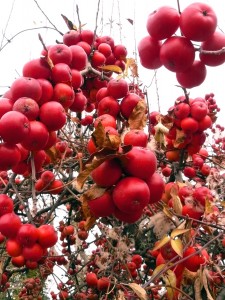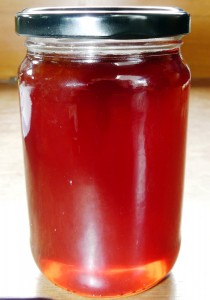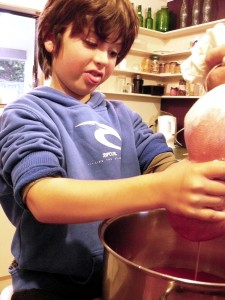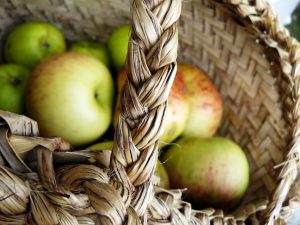By Kristina Jensen
Crabapples
Doesn’t the word just make you want to pucker up? Myself, I am always delighted to find the little bright clusters of these tiny sour apples because, for me, crabapples mean jelly. When everything else is dying away in the fall, crabapples just keep on shining in the pale light, providing food for birds and food for us, too — if we are willing to go harvesting.
When I was growing up, the crabapple tree in our backyard was a gnarly old thing, laden every year with millions of hard, sour apples. It was the finches’ favorite nesting place and my cat was an expert at crawling up the trunk to watch them. It was my job to gather the crabapples, ripping whole bunches unceremoniously from the spindly branches. Then my mother, Nancy (who passed away recently), would spend the morning making jelly. I feel very honored to be a recipient of her jelly-making skills and to have her encouragement to write about food and the satisfaction of living off the land.
Crabapple jelly for me is really all about my mom and how her unique characteristics as a cook and as a person emerged when she made jelly. Jelly making may look simple, but my mom’s jelly came with stern instructions. Once she strung up the jelly bag between two chairs, we children were forbidden to touch or, heaven forbid, squeeze the bag.
So here’s Mom’s rule: If you want perfectly clear, prize-winning jelly, don’t squeeze the bag!
Mom was a “waste not, want not” woman. She didn’t worry about the moths or the bird pecks — into the pot went kilos of crabby-looking crabapples She boiled them down to a pulp and carefully ladled the gloop into the ancient jelly bag. It would hang overnight in the pantry, protected from the fruit flies by an equally-ancient tent of curtain fabric kept just for the purpose.
The next day, she would measure out the beautiful, rosy-colored crabapple syrup and add cup for cup of sugar and create the delightful spread that we enjoyed all winter on our morning toast. Just in case you are thinking, “What a lot of sugar!” hear this: I’ve tried to make it with less sugar but (a) it doesn’t set right, and (b) it doesn’t taste “like mother used to make” so I stick to the rules on this one.
Crabapples are often overlooked as sour and useless, but I can assure you that you will be a convert once you have made a batch of jelly. You don’t have to stop at crabapples either. I have included another jelly recipe that follows much the same directions. Remember, if you want a clear jelly, don’t squeeze the bag!
Crabapple jelly
Pick yourself a bucket of crabapples. Leave some for the birds; crabapples are a good food source when the weather gets cold. I take the stalks off and cut them in half if they are very big. Unlike Mom, I also tend to discard any badly moth-infested ones.
Bring apples to boil in a big, thick-bottomed pot with ½ – 1 cup of water.
Stir often as they begin to heat up, then turn down the heat and simmer for 30 minutes until completely mushy.
Cool the mush down a bit, then pour into a jelly bag and hang it carefully between two chairs with a pot underneath.
The next day, measure your syrup and add 1 cup of white sugar for every cup of juice.
Bring slowly to boil, then simmer, stirring constantly, for 20-30 minutes until it begins to set. Crabapple jelly often has a frothy scum on top while it’s cooking and you can remove it if you wish. Mom always added a tiny knob of butter about 20 minutes in which she said stopped the scum from forming.
It sets fast, so have your hot, sterilized jars ready.
[The USDA and FDA do not recommend “open kettle” processing. Check your canning manual for correct processing times. — Editor]
Crabapple cordial
If you just can’t bear to waste all that liquid that you know is still hiding inside that jelly bag, then do as Theo is doing in the photo and squeeze the bag. You will end up with a strong, tasty thick syrup that is perfect for making cordial.
Add ½ cup of sugar to each cup of syrup and simmer gently for 20 minutes. When the liquid has cooled down, add 1 tsp of citric acid for each pint and bottle. It’s a delightful drink, especially served hot with a stick of cinnamon to spice it up.
Windfall apples
My father is Danish and my brother and I loved to hear him tell us stories about food gathering when he was a child. One of the favorites was how he used to watch for the first blossoms to appear on the apple trees. Despite the cold biting wind, tender buds would begin to show their faces in the pale light of spring. One winter, he found a couple of last season’s apples lying behind a barrel in the pantry on the cool side of the house, their withered, puckered skin like the faces of old women. We could almost smell and taste that apple as he told of how he picked one up and inhaled its familiar summer perfume. There was only a hint of moisture left in it, but that tiny amount of juice carried the promise of apple abundance. He immediately envisioned the time when he could swap his prickly woolen trousers for shorts with pockets that he could stuff full of new apples.
I am fortunate that my parents lived in a time when much of what they ate was harvested locally. A large part of their lives was devoted to the preservation of fruit, vegetables, and meat for times when fresh food was not available. Their stories guide and encourage me in my own journey to eat naturally-grown food. While most these days would rather trundle off to the store, I prefer to gather my own food whenever possible.
Windfall apple & sage jelly
This is great served with lamb, pork, and sausages.
3 kg tart windfall cooking apples (6.6 lbs)
1 liter of water (1.75 pints)
5 good-sized sprigs of sage
1 liter of malt vinegar (1.75 pints)
sugar – equal cup for cup to the strained juice (approx 1.5-2 kg or 2.5-4 lbs)
Wash the apples and cut into rough chunks; do not peel or core.
Bring to boil in a saucepan with water and one sprig of sage.
Reduce heat and simmer for 1 hour until apples are pulpy.
Add vinegar and boil rapidly for 10 minutes.
Strain the apple mixture through a jelly bag. Leave it hanging overnight, if possible.
Measure the liquid and put in back into a clean saucepan.
Add 1 cup of sugar for each cup of liquid.
Dissolve over a low heat, stirring occasionally.
Once dissolved, bring to a boil and cook for 10-15 minutes or until setting point is reached.
Finely chop remaining sage and add to jelly.
Remove any scum that has formed and pour jelly into warm, sterilized jars.
Seal and label.
To sterilize jars for jelly:
Wash the jars in hot soapy water, rinse thoroughly, towel dry, and pop into a medium temperature oven to heat up for 10-15 minutes.
Place the lids in a bowl full of very hot water.Remove each jar carefully with an oven mitt or towel and fill with jelly using a jug or ladle.
Wipe off any spillage on the neck of the jars with a clean damp cloth before you screw on the lids.
[The USDA and FDA do not recommend “open kettle” processing. Check your canning manual for correct processing times. — Editor]
After you have labeled each jar, line them up so you see the light shining through them, and then as Laurie Colwin, author of Home Cooking, recommends — tell yourself what a good person you are.

